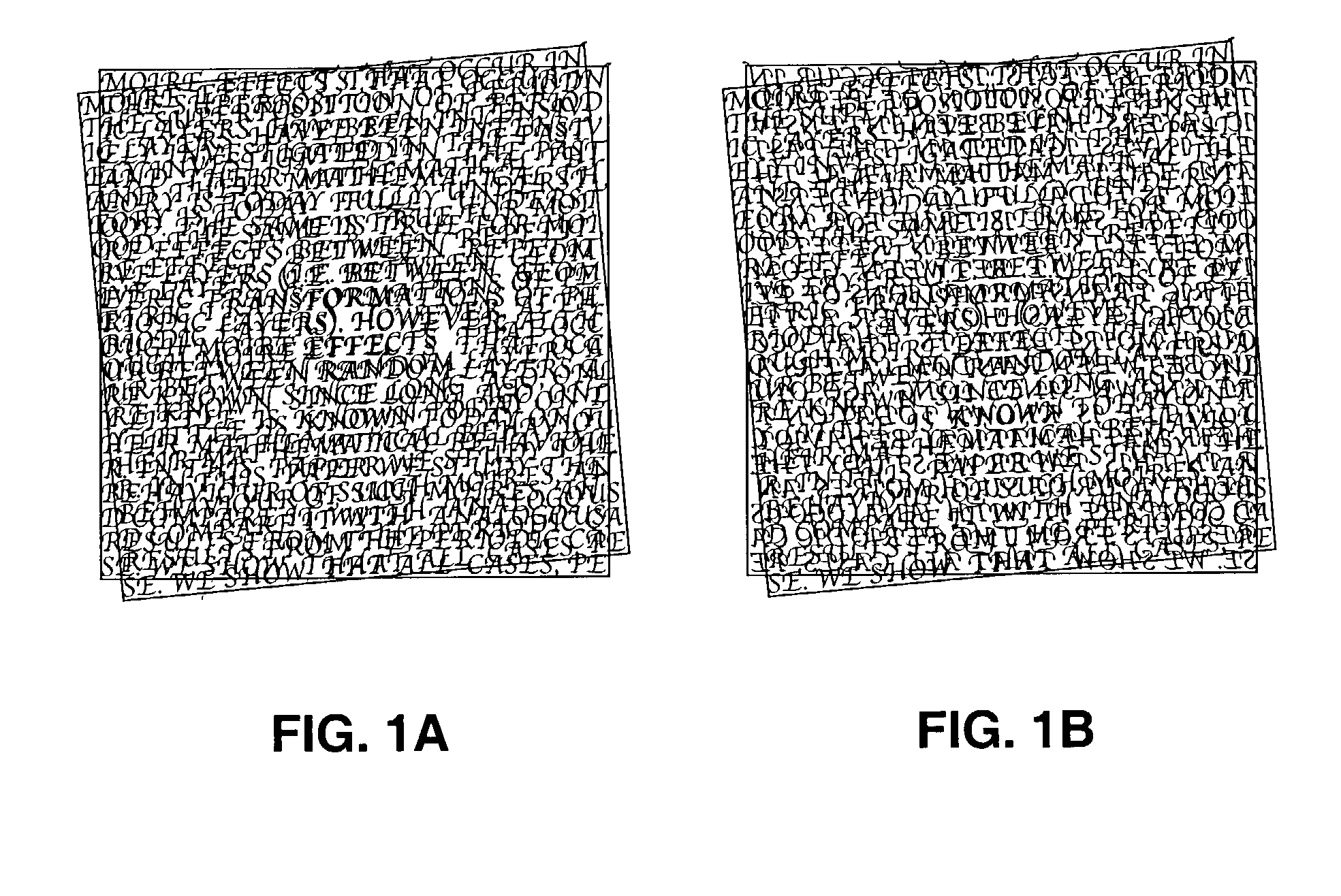Authentication with built-in encryption by using moire intensity profiles between random layers
a technology of intensity profile and random layer, applied in the field of authentication methods and devices, can solve the problem of not being able to avoid the repetitivity of moire intensity profiles, and achieve the effect of difficult counterfeiting
- Summary
- Abstract
- Description
- Claims
- Application Information
AI Technical Summary
Benefits of technology
Problems solved by technology
Method used
Image
Examples
example 1
[0093]A single moire intensity profile which is generated by the superposition of two random dot-screens on top of each other:
[0094]Let r1(x,y) be a random basic screen whose individual dots have the shape of the digit “1” as shown in FIGS. 12A and 12B, and let r2(x,y) be the corresponding random master screen whose individual dots are tiny pinholes with the same coordinates as the randomly located dots of the basic screen (FIGS. 13A and 13B).
[0095]In one preferred embodiment, the random locations of the screen dots are generated by a sequence of random numbers, that are obtained, as widely known in the art, by a random number generator. The random numbers thus obtained are first normalized to fall within the given dimensions of the screen, and then they are used as x and y coordinates for the locations of the dots of our basic and master screens. In a second preferred embodiment, the random numbers are not used as the coordinates themselves, but they are normalized to a small symme...
example i
Basic Screen and Master Screen on Same Document
[0120]Consider as a first example a document comprising a random basic screen with a basic screen dot shape of the digit “1” (like FIG. 12). A different area of the document comprises a random master screen, for example, with a master screen dot shape of small white pinholes (like FIG. 13), giving a dark intensity level. The document is printed on a transparent support.
[0121]In this example both the basic screen and the master screen are produced with the same random dot locations. The moire intensity profile which is obtained when the basic screen and the master screen are superposed has the form of the digit “1”, as shown in FIG. 14. As explained above, although the basic screen and the master screen are random, a clear moire intensity profile is produced in the superposition, and it has a good tolerance to both shifts and rotations.
[0122]It should be noted that the pinholes of the master scren and / or the dot shapes of the basic scree...
example ii
Basic Screen on Document and Master Screen on Separate Support
[0124]As an alternative to Example I, a document may contain a random basic screen, which is produced by screen dots of a chosen shape (possibly being incorporated in a halftoned image). The document is printed on a transparent support. The random master screen may be identical to the master screen described in Example I, but it is not located on the document itself but rather on a separate transparent support, and the document can be authenticated by superposing the basic screen of the document with the separate master screen. For example, the superposition moire may be visualized by laying the document on the master screen, which may be fixed on a transparent sheet of plastic and attached on the top of a box containing a diffuse light source.
PUM
 Login to View More
Login to View More Abstract
Description
Claims
Application Information
 Login to View More
Login to View More - R&D
- Intellectual Property
- Life Sciences
- Materials
- Tech Scout
- Unparalleled Data Quality
- Higher Quality Content
- 60% Fewer Hallucinations
Browse by: Latest US Patents, China's latest patents, Technical Efficacy Thesaurus, Application Domain, Technology Topic, Popular Technical Reports.
© 2025 PatSnap. All rights reserved.Legal|Privacy policy|Modern Slavery Act Transparency Statement|Sitemap|About US| Contact US: help@patsnap.com



